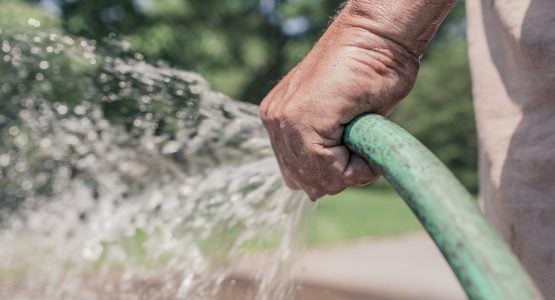Watering your garden: the complete guide

As any keen gardener will know, the key to a flourishing garden is proper hydration. But it can be hard to know the best methods and routines to stick to. How much water do certain plants need? What time of day is best for watering? Do you need to water every day? In this blog we’ll cover all of the questions you may have, and provide our recommendations for watering best practices!
The best times to water your garden
Watering your garden at the right time is crucial for the health and vitality of your plants. The best time to water your garden is typically in the early morning, ideally just after sunrise, or during the late afternoon, shortly before sunset.
Early Morning: Watering your garden in the early morning has several advantages. The temperatures are cooler, so there is less evaporation, ensuring that more water reaches the roots of your plants. Morning watering also allows the foliage to dry before night-time, reducing the risk of fungal diseases. Plus, it provides your plants with the moisture they need to start their day, promoting healthy growth and photosynthesis.
Late Afternoon: Late afternoon watering is another good option, especially if you can’t water in the morning. By this time, the sun’s intensity is waning, and the air temperature is decreasing. Watering in the late afternoon gives your plants time to absorb moisture before the cooler evening sets in. However, avoid watering too late to prevent your plants from staying wet overnight, which can invite fungal issues.
Avoid watering during the hottest parts of the day, typically from late morning to early afternoon. Watering during these hours can lead to excessive evaporation, and the intense sunlight can scorch wet leaves, causing damage to your plants.
Ultimately, the best time to water your garden depends on your climate, soil type, and specific plant needs. Regular monitoring and adjustment of your watering schedule are essential for maintaining a healthy and thriving garden.
Watering a vegetable garden
Many people ask whether they need to water a vegetable garden every day. The truth is that it’s not a case of one-size-fits-all, and different vegetables require different levels of watering! What they do all need is to be watered fairly deeply (around 30cm), and to be kept free of weeds to ensure no moisture is lost.
Particularly leafy crops like spinach and lettuce should always have plenty of water at every stage of growth. Root vegetables on the other hand can last longer without water, with potatoes and carrots needing a drink every 14 days or so. Onions and shallots need even less, requiring water only during very dry spells.
Watering in a greenhouse
Plants in a greenhouse are unique in that they have no access to natural water sources, so they’re entirely dependent on you for hydration. It’s a big responsibility! The most important thing to remember is that every plant in your greenhouse will have different water preferences, so you’ll need to take a varied approach.
Some plants seek to replicate their natural climate, so might prefer to dry out between waterings. For instance, you’ll only need to water a cactus when it’s become nearly completely dry. Others like herbs will want a few days between watering. Try to group plants with similar watering needs together to make things more simple.
Making sure that you’re watering thoroughly is the most important thing. As a rule of thumb, you should give your plants a quick drink to start with, then let that water soak in before watering again more extensively. The water should just be running out of the bottom of the container by the end, indicating that it’s reached the roots.
Of course, watering by hand isn’t the only method when it comes to your greenhouse. There are a range of systems you can use to keep your sheltered plants hydrated, from sprinklers and overhead sprays to drippers that add water slowly and efficiently. Take your pick and watch your greenhouse flourish.
Tips for water conservation
Water is a valuable resource, and we should all be doing our bit to use it more responsibly – and the garden is no exception! Understanding your plants’ watering requirements is the key to helping preserve water as best you can, while still nourishing your garden to its fullest.
Here are some of our top tips and information to keep in mind for more economical watering:
- Newly planted areas are the highest priority for watering, as they’re particularly vulnerable to water-stress.
- Lawns generally need a lot of water, but as it’s such a large space it shouldn’t be top of your priority list, even during particularly dry periods. Instead, try mowing less frequently and less closely to the ground.
- Remove weeds frequently, as these drain moisture reserves in the soil.
- Trees and shrubs that are already established do not need watering, but those that have been planted within the last five years should be watered to prevent drought-stress.
Ultimately there are no strict rules when it comes to watering, but we can be sure that irregular or insufficient watering is a sure-fire way for your plants to come into difficulty. By keeping up a proper watering regime, you can help your garden to thrive all year round.
For more tips on maintaining a healthy garden (and greenhouse), check out the rest of our blogs or check out this article on the RHS website.
